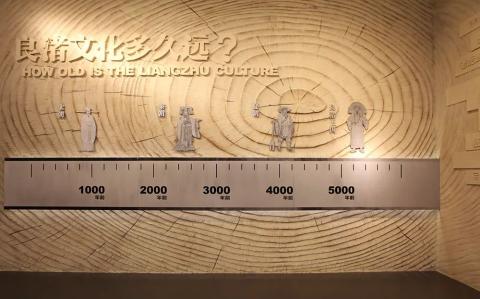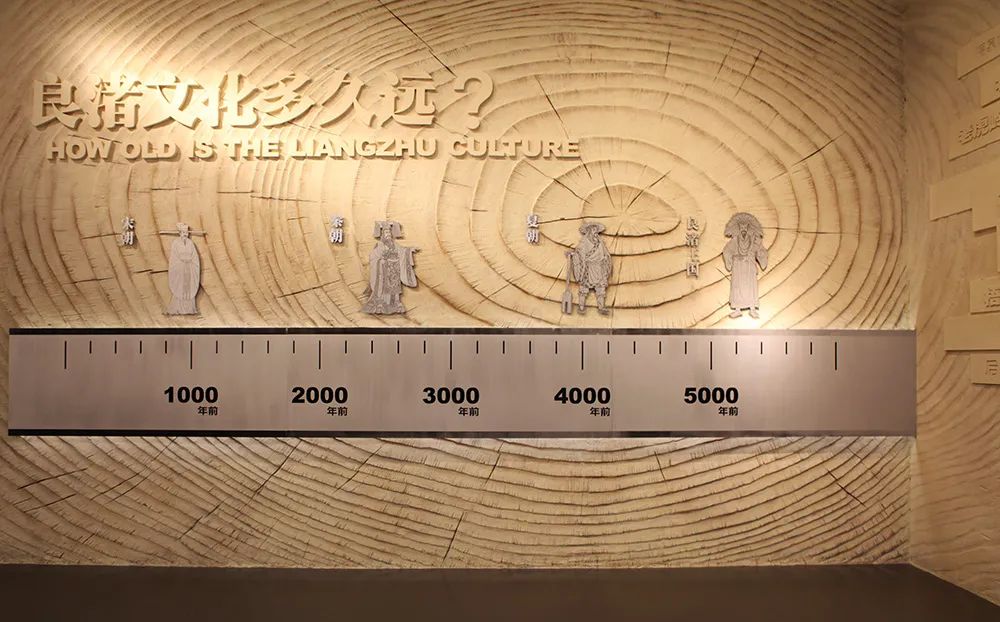
On July 6, 2019, [Liangzhu Ancient City Ruins] was officially approved to be included in the World Heritage List at the 43rd World Heritage Conference held in Baku, the capital of Azerbaijan. This is one of the world cultural heritages officially recognized by the international archaeological community after more than 80 years of exploration and research since China first discovered the Liangzhu cultural relics in 1936. In the "zero" issue of the series of columns "Xi Travel Notes", join me into the world of Liangzhu ancestors and explore the ancient times.
▲ Liangzhu Museum is located in Liangzhu Street, Yuhang District, Hangzhou CityLiangzhu Museum currently has three major exhibition halls, with the themes of "Water Country," "Holy Land of Civilization," and "Jade Soul, National Spirit" respectively. They display Liangzhu through a combination of relic display and scene simulation. Culture plays an important role in the historical development process of "diversity and unity" of Chinese civilization.The reason why it is called the "Water Country" is closely related to the remains of large-scale water conservancy projects discovered during the archeology of the ancient city of Liangzhu. There are abundant lake resources around the ancient city of Liangzhu. The ancestors of Liangzhu used this natural resource to build dams to resist flash floods from high mountains, and to develop canals to transport materials, irrigate farmland, and fish. Aquaculture and other daily uses.
 Judging from the animal remains and carbonized seeds found at the ruins, the ancestors of Liangzhu used a combination of hunting and farming to obtain food. Among them, the most well-known animal is the pig (hog). Among the remains of animal bones, the proportion of domestic pigs is as high as 80%. In terms of plants, there are not only aquatic and terrestrial plants such as jujube, walnuts, melons, and water chestnuts, but also rice, which continues to be one of the staple foods. Stone plows and other tools found at the site confirm that farming technology reached a relatively mature level at that time.▲ Remains of southern jujube cores (picture from the official website of Liangzhu Museum)In the Neolithic Age, the ancestors of Liangzhu could already use clay as raw material and bake it into utensils with various functions for cooking, banquets, storage, etc.
Judging from the animal remains and carbonized seeds found at the ruins, the ancestors of Liangzhu used a combination of hunting and farming to obtain food. Among them, the most well-known animal is the pig (hog). Among the remains of animal bones, the proportion of domestic pigs is as high as 80%. In terms of plants, there are not only aquatic and terrestrial plants such as jujube, walnuts, melons, and water chestnuts, but also rice, which continues to be one of the staple foods. Stone plows and other tools found at the site confirm that farming technology reached a relatively mature level at that time.▲ Remains of southern jujube cores (picture from the official website of Liangzhu Museum)In the Neolithic Age, the ancestors of Liangzhu could already use clay as raw material and bake it into utensils with various functions for cooking, banquets, storage, etc.
"Dou" and "ding" were the names of utensils in ancient China. Dou was generally used as a vessel for holding water or food, while tripod was mostly used for cooking. From the physical remains found at the site, we can understand the inheritance and continuity of culture.
▲ Oval-shaped plate with talisman and pottery beans (picture from the official website of Liangzhu Museum)▲ Tao Ding (picture from the official website of Liangzhu Museum)After food survival conditions were guaranteed, building various civil engineering projects as habitats was one of the indispensable elements for the Liangzhu ancestors. Under the clan and tribal structure at that time, there was a top-down social class system, which could be roughly divided into royal family, high-ranking nobles, low-ranking nobles and commoners.
▲ The Liangzhu cultural housing model restored after verification,Different shapes due to different classesIn terms of material civilization, in addition to farming and building buildings, the Liangzhu ancestors also processed stones into spinning wheels, used them to weave linen, and made various types of clothing. They moved from primitive tribes with "no clothes to cover their bodies" to a more modern society. For a mature social civilization.
In terms of spiritual civilization, in order to emphasize the ruling idea of "divine right of kings", the Liangzhu ancestors began to make various jade articles. Among them are the ritual utensils [Jade Cong] (ceremony to the earth), [Jade Bi] (ceremony to the sky), which symbolize communication with the gods, and [Jade Yue] (axe), which symbolizes royal power and military power, as well as jade items that highlight status. Headwear, rings, necklaces, etc.
At the same time, some of the cultural relics discovered at the site are also accompanied by many "engraved symbols" that represent a certain meaning, which can be understood as a carrier for recording things at that time.
Carved pottery pot (with details)
Due to its rich social elements, the Liangzhu Culture was superior to many Neolithic Age cultures in terms of construction planning. The entire ancient city of Liangzhu consists of the inner city (living area), the outer city, as well as water conservancy projects and altars on the outskirts of the city.
The Mojiaoshan palace ruins in the inner city are located higher than other residential areas, indicating that they can be closer to God to receive divine revelation and blessing. This is not only reflected in the construction of traditional palaces in ancient China, but also confirmed by ruins in other regions (such as the Maya in Central America and the Inca civilization in South America).
▲Mojiaoshan Palace Area ModelIn civilian living areas, there are areas dedicated to handicraft production. There are craftsmen who produce pottery, woodware, and stoneware, as well as craftsmen who are engaged in making jade. They are adjacent to the water and perform their own duties. This vibrant scene is presented in the exhibition area through 3D printing technology.▲ Zhongjiagang Ancient River Workshop Area ModelRelying on the peripheral water conservancy projects on the outskirts of the city, the Liangzhu ancestors introduced river water into the city and completed daily transportation of materials through canoes, bamboo rafts and other tools.▲ The remains of the ancient well▲ Canoes and bamboo rafts were the main means of transportation at that time
In the northwest of the outskirts of the ancient city, there is the mysterious Yaoshan ruins. In addition to the altar for Liangzhu ancestors to pray, there are also more than ten tombs, which is a complex ruins. The altar was built using natural mountains, and trenches were dug and filled with gray soil to form a triple glyph, which may be related to astronomical observations. There are more than 700 pieces (groups) of relics found in these tombs, and most of them are jade articles, which shows that the tomb owners had a noble status.
As a symbol of belief in the Liangzhu culture, the patterns of gods, humans and animals have been found in many relics unearthed from Liangzhu cultural sites. The interpretation of the overall structure can be divided into the image of a human face wearing a feather crown in the upper part, the appearance of a ferocious beast with angry eyes in the middle, and the sharp claws of a bird in the lower part.(Picture from the Internet)The "Jade Cong King of Liangzhu Culture" that appeared in the CCTV cultural museum program "National Treasure" (now in the Zhejiang Provincial Museum) has four straight grooves on its surface carved with several patterns of gods, humans and beasts.
▲ The Jade Cong King of Liangzhu Culture (the red circle is the location of the facial decoration of gods, humans and animals)
(Picture from the Internet)Regarding the interpretation of the meaning of the patterns on the faces of gods and beasts, the archaeological community speculates that the shape of the human face refers to the image of the priest who was engaged in sacrificial rituals at that time, the appearance of the beast is a symbol of respect for nature, and the sharp claws of the birds are pictograms that can be found through the ruins. One of the jade objects [Jade Bird] is derived from it, which is a manifestation of communication with the gods. This complex pattern of humans, animals and birds, a trinity, also corresponds to the diverse integration of Chinese civilization.
▲ Jade Bird ( Picture from Liangzhu Museum official website )"The Rites of Zhou" has a description of "using blue jade to worship heaven". Jade has always played the role of "inheriter" in Chinese history. Even in different periods of history, there are different patterns or carving techniques on the surface of jade (yin). (engraved, embossed, hollowed out) to display, but its beautiful and noble core meaning has not changed. Among the jade bis unearthed from the Liangzhu Cultural Site, most of them are plain or inscribed.
In addition, various types of jade decorations found in royal cemeteries, after archaeologists restored the burial rituals, showed the audience how the Liangzhu ancestors dressed up to show off their appearance.After visiting the three themed exhibition halls, you can see many cultural and creative products related to Liangzhu culture in the cultural and creative space inside the museum. If you feel a little tired after watching the exhibition, you can sit outside for a while.
The core area of Liangzhu Ancient City Ruins is located in Pingyao Town, Yuhang District, Hangzhou City, adjacent to Liangzhu Street. After enclosure protection and construction, it has been officially opened to the outside world.▲ The park stone logo at the south gate of the park
The area currently available for tours is the inner city area, the core area of Liangzhu Ancient City ruins, covering an area of approximately 3.66 square kilometers. There are sightseeing buses connecting major tourist spots (additional tickets are required, not mandatory). If you are not confident in your foot strength, it is recommended to take a bus to travel everywhere.
At present, the internal infrastructure of the park is still being upgraded and expanded, and more tourist spots will be opened for people to enjoy.
▲An ancient river channel that reproduces the style of that timeIn the Zhongjiagang ancient river workshop area mentioned above, you can see a variety of sculptures of different shapes. The scene of "traffic on the road, chickens and dogs hearing each other; going back and forth to plant, and feel at ease" has been faithfully restored.
The Mojiaoshan Palace Ruins Area is composed of two parts: the sand square and the palace high ground. The sand square was used for large ceremonies at the time, and the sign explains how to ram the earth to create the building. There is a bird's-eye view sculpture of Liangzhu Ancient City on the palace high ground, which can be used to confirm the orientation and layout of the ancient city.
When you come to the Fanshan ruins area (Mausoleum of Fanshan King) where King Jade Cong was discovered, you can learn about the information of the tomb owners of each tomb and the analysis of the age of each soil layer during the archaeological excavation period.
Not far to the west of Fanshan ruins is the West City Wall ruins exhibition area. The ancestors of Liangzhu used the outer city river here to transport the stones needed for construction and then moved them to the inner city area.
This is the end of the museum + site visit.In the long river of human civilization, Liangzhu Culture, as one of thousands of historical boats, carries the Liangzhu ancestors’ reverence for gods, pursuit of faith, and desire for a livable life. It started five thousand years ago Driving slowly, we invite future generations to reminisce about this former Taoyuan land.



























































































































